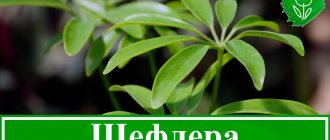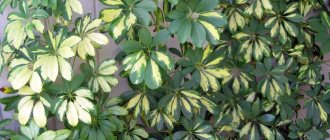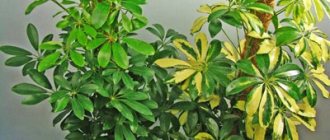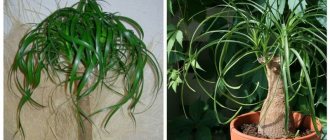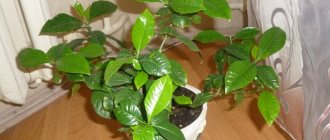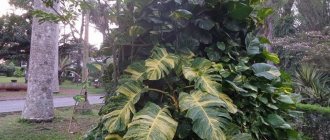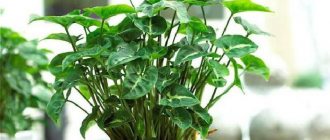Schefflera is an evergreen perennial shrub or tree belonging to the Araliaceae family, a distant relative of ginseng. In its natural habitat - Australia, the Pacific Islands, Southeast Asia - there are more than 200 species of this plant. About 10 of them are grown indoors.
In an apartment, shefflera can grow up to 2 meters, adding 30-40 cm per season. The leaves have a palmate-dissected shape with 4-12 lobes, resembling a palm with outstretched fingers. Because of this leaf structure, Schefflera is sometimes called an umbrella tree.
The color of the leaf blade is plain green or with white, cream, yellow spots and streaks. White, yellow or crimson flowers are collected in racemes or paniculate inflorescences, similar to tentacles. In indoor conditions it blooms very rarely.
| Growing quickly. In one season, the plant gains 30-40 cm in height. |
| It blooms very rarely. |
| The plant is easy to grow. |
| Perennial. |
Useful properties of shefflera
Schefflera improves the environmental conditions of the room in which it grows: it increases air humidity and saturates it with air ions and ozone, and removes benzene.
The umbrella tree contains toxic substances that irritate the skin and mucous membranes. Therefore, it is better to keep it away from small children and pets, and after contact with the plant, wash your hands thoroughly.
Trimming
Schefflera looks more abundant and lush when several plants are placed in one pot. For bushy growth and to combat height, it is recommended to prune it from time to time.
If the plant grows upward, it will eventually become long and have little foliage. The best time for cutting is spring, but no later than May. The main recommendations for pruning are:
- long shoots can be cut back by two thirds
- accidental pruning of shoot tips promotes the growth of new side shoots
- always trim above buds
- knotty joints on the trunk form numerous new shoots
- cut off old inflorescences, if any
- regularly remove diseased and limp parts of plants
This plant is also undergoing drastic reduction. The remaining cuttings can be used to grow new cheflers. If the sheflera is still young and if more plants are grown in one pot, the sprouts can be twisted together. This makes them an optical eye-catcher. However, you should wear gloves when handling this plant because all parts of the plant are poisonous. This is very important to know when you have small children and pets in your home.
Schefflera lends itself well to shaping. The height can be adjusted by trimming the top. The plant will send out side shoots, which will subsequently create a spherical shape. You can give it the shape of a bush by planting several cuttings nearby. If you need to grow a tree, you should cut off the lower side leaves. In this case, accuracy is important to avoid loss of decorativeness.
Shephlers carry out formative pruning in early spring. It is necessary to complete this procedure before active growth begins, so as not to weaken it and damage the growing shoots. When growing a bush, 3-4 cuttings are planted in one container. Formation begins when they grow 5-6 internodes in length. After this, in the spring their tops are pinched. This will cause the young plants to branch. Usually, after pinching, 2-3 new shoots grow on each cutting, which are also shortened the next year to get a lush bush. During standard formation, the lower shoots are removed to a height of 20 cm from the ground, and the top is pinched. In the future, every spring it is necessary to trim the growing shoots in accordance with the desired crown shape.
Caring for shefflera at home. Briefly
| Temperature | In summer - 20-25 degrees, in winter - 18-20 degrees, but not lower than 12 |
| Air humidity | High, regular spraying is recommended. |
| Lighting | Schefflera at home needs bright diffused lighting, the optimal place is an eastern window sill. |
| Watering | Moderate, avoid waterlogging; in summer – 2-3 times a week, in winter – once every 7-10 days. |
| Priming | Nourishing, lightweight, breathable. |
| Feeding and fertilizer | During the growing season, apply liquid fertilizer for decorative foliage plants once every 2 weeks. |
| Transfer | Once every 2-3 years, the top layer of soil in the pot is replaced annually. |
| Shefflera propagation | Apical cuttings, layering, seeds. |
| Peculiarities | It requires support and sometimes pinching to form a bushy shape. |
Temperature
Sheflera requires relative coolness to thrive. Comfortable temperature range: +18o – +22o. At higher temperatures (for example, in hot summers, if it is not possible to ensure a comfortable temperature), frequent spraying is recommended.
In summer, in warm weather, it is recommended to take the chefler out into the fresh air, providing protection from wind and drafts.
In winter, the shefflera is placed at a sufficient distance from heating devices and provides additional air humidification. It is possible to lower the temperature to +16o - +18o. At temperatures below +12o the plant dies.
! An important point for the health of sheflera is protection from drafts .
Sheflera variegated
Caring for shefflera at home. Details
Scheffler's care at home does not require too much care. Even a novice gardener can grow it. It takes root well in modern apartments if you give the plant a little time and attention.
Planting shefflera
Time for sowing seeds: mid-January - end of February. To improve germination, it is recommended to soak them in a growth stimulant, for example, Zircon or Epine.
The soil consists of equal parts of turf, leaf soil and sand. Another option is sand and peat in a 1:1 ratio. The seeds are sown to a depth of 5-6 cm, at a distance of 3-5 cm from each other. It is recommended to cover the container with a plastic bag and place it in a warm (20-25 degrees) place. The greenhouse should be regularly ventilated and watered so that the soil does not dry out.
When the seedlings have 3-4 leaves, they are transplanted into individual pots with a diameter of 10-12 cm. For 3 months after transplantation, it is recommended to keep the plants at a temperature of 19 degrees.
Bloom
Schefflera blooms with inconspicuous white, cream, greenish or red flowers collected in paniculate, racemose or umbellate inflorescences.
Outwardly, they resemble tentacles. They have no decorative value. At home, the umbrella tree blooms extremely rarely. Does not require special care during this period.
Temperature
Homemade shefflera feels great at normal temperatures in the apartment. She does not need to create special conditions. In summer, the optimal thermometer readings for it are 20-25 degrees, in winter – 18-20 degrees. Varieties with green foliage normally tolerate temperature drops of up to 12 degrees, variegated ones - no lower than 16 degrees.
In winter, it is better to place the plant away from heating devices, since hot, dry air causes leaves to fall off. The umbrella tree is also afraid of drafts and sudden temperature changes.
Spraying
Schefflera prefers high environmental humidity. Regular spraying with a fine-grained spray bottle will help create such conditions. In summer, it is recommended to carry out the procedure 2-3 times a week, in winter, with the heating on, every other day. Soft filtered water is used.
To increase air humidity, a pot with a plant can be placed in a tray with wet pebbles or expanded clay. Another way is to place a container of water near the flower.
Shefflera leaves should be wiped from dust with a damp cloth once every 3-4 weeks.
Lighting
Schefflera is a light-loving plant . In autumn and winter, the optimal place for it will be a southern window sill, in spring and summer - an eastern or western one. When the sun is especially active, direct rays can cause burns on the leaves. In this case, the plant should be shaded with a translucent curtain or placed on a bedside table near the window.
With a lack of lighting, variegated varieties lose the brightness of their leaf color. In this case, it is recommended to illuminate them with phyto- or fluorescent lamps.
In summer, the shefflera can be taken out onto the balcony or into the garden, having previously prepared a place for it protected from the wind and direct sunlight.
Watering scheffleras
Schefflera at home needs regular but moderate watering. In summer it is more frequent - 2-3 times a week, in winter (if kept cool) it is scanty - once every 7-10 days.
The need for regular watering will be indicated by the dried top layer of soil. If we talk about extremes, then the plant tolerates overdrying of the earthen coma better than its waterlogging. The latter is fraught with rotting of the root system and blackening of the foliage.
For irrigation, rain or settled water at room temperature is used.
Shefflera pot
The size of the pot depends on the size of the flower. For the first time, seedlings can be planted in plastic cups, and when the root system fills the entire space, transplanted into pots 2-3 cm larger in diameter and height.
An adult plant is transplanted into a pot, the diameter of which is 3-5 cm larger than the previous one. The pot should always have holes to drain excess water.
Soil for shefflera
The soil for shefflera should be nutritious and light, well permeable to moisture and air. Of the store-bought substrates, soil for ficus or palm trees is best suited. If you have the opportunity to prepare the mixture yourself, you can choose one of the options:
- Turf soil, coarse sand, peat, humus and leaf soil in equal parts;
- Turf soil, leaf soil, river sand and humus in a ratio of 2:1:1:1;
- Turf soil, humus, sand (2:1:1).
Feeding and fertilizer
To fertilize schefflera, it is recommended to use liquid complex fertilizers for decorative foliage plants. The frequency of fertilizing in spring and summer is once every 2 weeks, in autumn and winter – once every 2 months. The concentration should be 2 times weaker than indicated on the package.
Fertilizers are applied only after watering, so as not to burn the roots of the plant.
Shefflera transplant
The frequency of transplanting a Schefflera depends on its age. Seedlings are transplanted once every six months, as the space of the pot is filled with the root system.
Young plants - once every 2 years, and adults - once every 3-5 years. It is recommended to replace the top layer (about 5 cm) of soil annually. When transplanting, a drainage layer must be placed on the bottom of the pot. The safest and easiest way to transplant is transshipment together with an earthen clod.
Trimming
Schefflera flowers, as a rule, do not need pruning at home. The exception is when the plant has become too elongated and has lost its decorative appearance. Then long branches are shortened to promote the appearance of young shoots. The optimal time for such pruning is spring.
To give the shefflera a bushy shape, you need to pinch the tops of the shoots. The tree-like form often requires support.
Rest period
Schefflera does not have a clearly defined rest period. However, like most plants, in winter it slows down or completely stops growing.
During this period, it is necessary to reduce the frequency of watering and move the pot to a bright, cool place (16-18 degrees). Such a “rest” will increase the immunity of the umbrella tree and promote active growth and development in the spring.
Accommodation
Schefflera is a light-loving plant. The ideal placement would be western or eastern windows.
On south-facing windows, you can place the plant near the window. If the cheflera is on a windowsill, then shading from direct sunlight is required . During the summer months, the sun's rays can cause burns on the leaves.
In the north, lighting is required for variegated forms, which require more light than green ones, and with a lack of light they quickly lose their decorative effect.
The general rule would be an abundance of light, but not direct, and relative coolness.
! From excess heat or lack of light, Schefflera sheds its leaves.
Shefflera propagation
Schefflera propagates in two main ways: cuttings and layering.
Shefflera propagation by cuttings
Semi-lignified cuttings from the top of the shefflera are suitable for propagation. They are cut at an angle with a sharp knife. The lower leaves are removed. There should be 3-4 leaves left on the cuttings.
After treatment with a root formation stimulator (Epin or Zircon), the cuttings are planted in a mixture of peat and sand (1:1). The container is covered with polyethylene and placed in a warm (22 degrees) place. The soil must be regularly moistened so that it does not dry out, the cuttings must be sprayed every other day, and the greenhouse must be ventilated daily.
Rooted young specimens can be transplanted into separate pots after 3 months.
Reproduction by layering
A large, healthy plant is suitable for producing cuttings. In early spring, two circular cuts are made on the semi-lignified trunk, the distance between which will be 3 cm.
The bark between the cuts is removed. This place is wrapped in moss moistened in a solution of a growth stimulator (Zircon or Epin) and wrapped in plastic film. You should wet the moss with water from time to time to keep it moist.
After 3-5 months, roots should appear. After they grow and become stronger (another 1.5-2 months), the film and moss are removed, and the trunk of the plant is carefully cut below the level of root growth. The young specimen is planted in a new pot.
The remaining part of the “mother” plant is cut off at the root and continues to be watered. After some time it will give young shoots.
Diseases and pests
Difficulties with shefflera most often arise due to violation of the conditions of its maintenance. Here are some problems and their causes:
- Roots rot due to overwatering.
- Elongated and elongated shoots - lack of light or too high temperature.
- Schefflera leaves turn yellow and fall off - insufficient lighting.
- The leaves have turned black - excessive watering, the soil does not allow moisture to pass through well, lack of drainage.
- Schefflera leaves have become faded due to lack of lighting.
- Schefflera curls - lack of sunlight.
- The tips of the leaves are brown - low air humidity in the room.
- Schefflera green leaves fall off - the temperature is too high or too low.
- Brown spots on the leaves indicate excess moisture in the soil.
- Light spots on Schefflera leaves indicate excess light.
Among the pests that are dangerous for schefflera are spider mites, scale insects, mealybugs, and aphids.
Types of homemade shefflera with photos and names
Schefflera actinophylla
It has a powerful branching stem and elongated leaves on elongated petioles, with 14-16 lobes, 10-15 cm long. The color of the leaf plate is olive-green, golden-yellow or yellow-green.
Schefflera octophylla (Schefflera octophylla)
In young plants of this species, elongated leaves with a light vein have 6-8 lobes, in adults - up to 16 lobes. The color of young leaf blades is light green, old ones are dark green.
Schefflera arboricol
A tree-like liana with unpaired pinnate leaves with rounded ends, having 7-15 lobes. The plant practically does not branch, but produces shoots from the roots. There are varieties with green and variegated leaves.
Schefflera elegantissima
Grows up to 2 meters in height. Dark green leaves are planted on a thin gray-brown trunk, dissected into 8-12 thin lanceolate lobes, the length of which reaches 15 cm. The species practically does not branch.
Schefflera digitata
It has palm-shaped leaves, dissected into 7-10 lobes, 15-35 cm long. Oval-shaped lobes, pointed at the ends, 4-6 cm wide, 6-8 cm long.
A little knowledge, time and attention and a small shefflera will turn into a luxurious tree with a lush, dense crown!
Description of the plant
Scheffler's home flower is an ornamental foliage plant with palmately dissected leaves with 4-12 lobes, which look like a palm with outstretched fingers, solid green or variegated colors with yellow or white spots and streaks. Schefflera's inflorescences are elongated, racemose, tentacle-like, but you are unlikely to be lucky enough to see them, since the plant blooms only in nature or in a botanical garden.
In their natural habitat, the plants become true trees up to 20 meters in height. It is also cultivated in our climatic conditions, grown as an ornamental shrub with large leaves.
When grown at home in pots, the plant usually does not exceed two meters in height. The young plant can be grown together with other green plants. When the plant is large it looks great on its own.
The beauty of the flower lies in the palmate compound leaves formed from dissected sections (4-16) located on long petioles (30 cm). To enhance the decorative effect, it is recommended to cover the leaves with polish (a special composition that adds shine).
The peculiarity of the flower is that it has one trunk with springy branches that support the leaves. The trunk of some species becomes bare with age, leaving leaves only at the top. Schefflera is a light, graceful plant that, with proper care at home, lives for a very long time. Caring for the plant is quite simple; it is based on two factors: watering and lighting.
